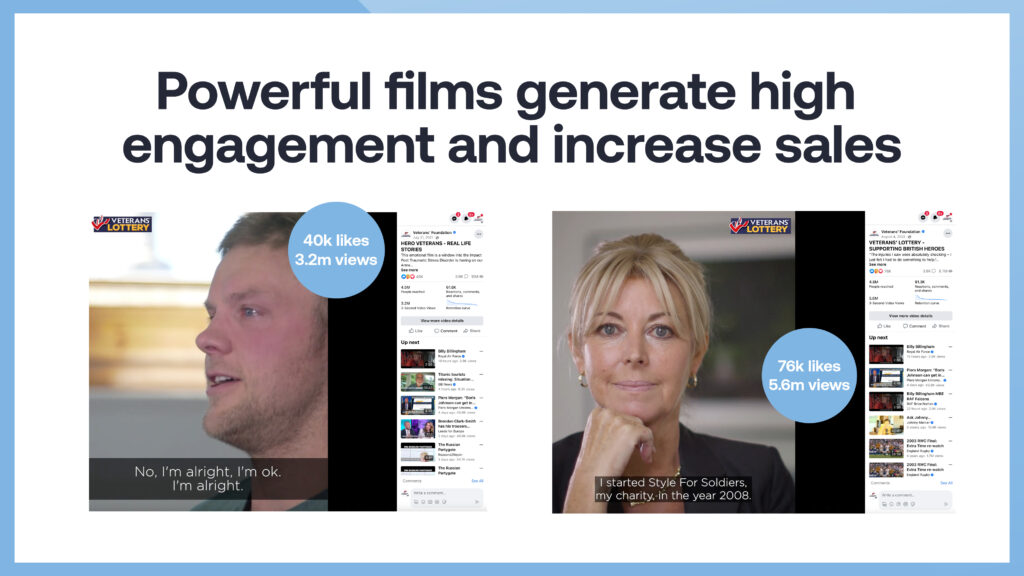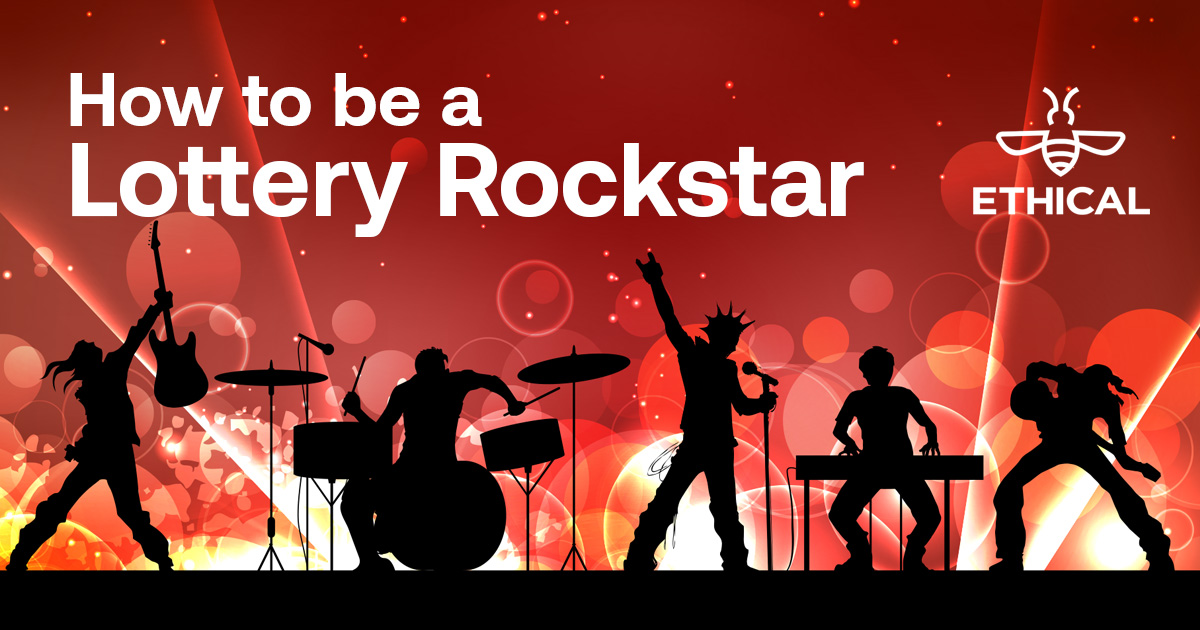In a world of escalating costs, running a charity lottery that’s in a ‘growth phase’ is becoming more challenging.
To help you prepare for a prosperous New Year, Bee Ethical’s Managing Director, Richard Lee, takes to the stage to give you three hit learnings to help you become a Lottery Rockstar in 2024.
Revealed are some key online lessons that have seen the company rise through the charts and create Britain’s biggest single cause charity lottery.
Harness the POWER of Social Media
The journey to performance-change starts with organic social media.
Yes, organic posting really is still crucial despite reach being a fraction of your page likes and follows.
Many charities, and not for profits, are very infrequent posters on social platforms. Research suggests the national average for the Third Sector is just seven posts per week.
If you only post a few times and that content isn’t getting shares or receiving high quality ‘reactions’ (care, love, laugh), as a result, your page ranking will be weak.
Why? Because algorithms need indicators telling them you’re a valuable content creator. Unfortunately a weak ranking could damage every aspect of your social media strategy.
Infrequent, low quality posts will result in a tiny pool of engaged consumers to remarket to. Less engagement and less people will inevitably lead to under performance.
Let’s play this organic story through…
One of the most popular advertising audiences on Meta is Facebook Engage; which consists of ‘warm’ people who have interacted with your page in a set date range.

Imagine two charities with the same offer – in this case a £1 a week lottery.
One boasts 1 million engagements from 60 posts in a week whilst the other has 5,000 engagements from 7 posts. Which charity is likely to enjoy the best lottery sales?
Giants such as Meta (Instagram and Facebook) reward pages that are popular, but they also punish (through restricting reach) those who post content that is too corporate or uninspiring.
Before you begin to understand the latest social media ad tools and trends, you must build a vibrant, engaged page.
Even with organic reach hugely suppressed compared to years gone by, developing an organic social strategy that is the best it can possibly be is a building block to lottery growth and fills your sales funnel with potential leads.
Key learning: Build reach, engage with the community, own your stage. This organic pot of people are highly valuable and are at the top of your sales funnel.
Content that ROCKS
If you want to rock the lottery world and fast track growth it is crucial you create the right content. Whether that’s for online advertising, organic posts or point of sale material, it has to be high-quality.
Emotion influences the big decisions consumers make; it’s the heart not the head that wins the day.
If you embrace that theory then the logical outcome is: the more emotive your communication, the bigger the potential win.
Yet a lot of charities see their lottery promotion as a chance to deliver an alternative style of advertising message, something which is different to their donation story.
This is a valid strategy but unfortunately this approach has a ceiling that can be expensive to push past.
How does everyone else do it?
Let’s take an overview of a typical online lottery advertising narrative.
Charity X builds an advert using a file picture of a happy couple punching the air. There is a headline (with drop shadow) stating they’ve just won £1,000 in the weekly lottery.
A few lottery ball graphics are layered over the top of the celebrating couple. This re-enforces that you are viewing a lottery promotion.
Finally, a charity logo and a ‘500 guaranteed cash prizes every week’ strapline completes the creative. Sound familiar?
We have a huge file of creatives in this style that have been collected over the past few years. There is little doubt this kind of promotion is the ‘go to’ for charity lottery.

In the short term, the strategy can be effective as you’re capturing existing donors and supporters. These individuals are ‘bottom-of-the-funnel’ brand advocates and you can almost always rely upon them to back your charity mission and products.
But a strategy of this kind can derail.
The major challenge by adopting this approach is that winning £1,000 isn’t that emotional for most.
Neither is winning £25,000 (your charity lottery maximum top prize). Especially when the Postcode Lottery and National Lottery are running rival advertising campaigns with ‘Win Millions’ as the key message.
Beyond your ultra-keen fans, very few heads will turn if your focus is on small cash prizes.
What does that mean for YOUR charity?
Well, once you collect your low-hanging fruit, player recruitment often slows. This is especially true when using platforms such as Instagram and Facebook.
The truth is, there are dozens of charity lotteries broadcasting the same advertising message at the same time. And they’re all competing against one another.
But that’s only part of the challenge, in addition, it’s the cost of the recruitment that’s a major concern. This is the Cost Per Mile (cost per 1,000 views of your advert).
In the section ‘Harness the power of social media’ (above), I explained Facebook’s disdain towards corporate messages. The Meta algorithm rewards content that has a like, a love or a share.
A lottery advert that focusses on small win pots (and also uses file photography) is interpreted by AI as poor quality content.
Promotions in this style do not get shares or loves in any volume because they lack the essential ingredient: emotion.
The end result means that Meta will shut down the post’s organic reach. Should you wish to bolster its performance with advertising revenue, you’ll be paying the very highest price for that service.
How does my charity get cheaper advertising?
The way to navigate this is to work with the algorithm and build emotion into your lottery promotions.
Charities have all got amazing real life stories to tell and they are broadcast most powerfully through video.
The more authentic your story is, the more reactions it will receive. Then you see the domino effect.
A video with increased reactions will be embraced by social media algorithms. This will result in a cheaper Cost Per Mile as it is pushed into more timelines.
And, finally, the pay off: higher sales at a lower price!
Our best online charity lottery sales day came on Facebook, utilising four hard-hitting real-life video stories to convert over 748 players. This came at a price of £28 per conversion.
On a £10 per month lottery model, that’s a return on investment in less than three draws. Those results are as good as they are ethical.
Key learning: Authentic storytelling will deliver more lottery players at a lower cost.

Attrition Buster
Filling the lottery player pool from the top is hard work. It’s essential you minimise the amount you lose in the hole at the bottom of your revenue bucket.
Every charity will have its own attrition management tactics and many will be familiar.
An instant text when signing up; a welcome phone call thanking the player for support; regular e-newsletters. With Bee Ethical’s lottery packages, all players are provided membership benefits through a joint venture with the Gourmet Society.
They all form a part in maintaining player support, particularly membership benefits which have seen soaring rates of take up.
However, there is an additional attrition buster that needs to be in your toolkit… and it’s ‘emotion’. There’s no escaping the importance of it to your lottery strategy.
The benefit of shifting gear from ‘Win £25,000’ graphics to ‘Change a life’ videography is transformational to lottery attrition.
Not only is every piece of video content you produce a powerful recruitment tool, it helps to fix your revenue bucket leak.

Strategy Switching
In the early stages of building our online strategy, we had a policy of blocking existing players who had watched lottery adverts. It was seen as wasted views and expense; far better to push your advertising to new audiences.
Then, over a three month period, we trialled broadcasting lottery adverts to the existing players pool… the results were jaw-dropping.
Cue a newsfeed swamped with messages about being ‘proud to play’. Month after month, what we believed to be the lowest attrition rate in the UK began to drop even further.
When you consistently recruit lottery players by placing emotion centre stage, it results in the creation of a community of highly engaged individuals. This relationship you have nurtured is very different to that of lottery players recruited through ‘win’.
The brand advocacy of this group can then be further developed via legacy, fundraise and donate. The supporters we have recruited have pledged millions to our charity partners.
Having seen the success of emotion on attrition, we have now expanded the test and trial process into face-to-face marketing.
The point of sale material has been reworked, many win messages have been replaced by emotive imagery. In the case of the Veterans’ Lottery, ex-servicemen and women have become a key part of the consolidation process – authenticity is paramount. The result has seen a 55% upturn on F2F attrition performance.
Key learning: Emotion should be centre stage in your customer interactions.
In Summary
There are many levers that need to be pulled when building, and maintaining, a high performance lottery – the three I’ve shared are just part of the jigsaw.
They have been chosen for impact. If you can adopt these principles into your lottery campaigns, they can quickly deliver exceptional results.
In a mature market like incentivised giving, most charities are pursuing marginal gains that collectively could move the needle. Reworking graphic ads to tweak headline placement; testing alternative demographics of target audiences; or adjusting budgets by percentage points are just a few examples.
Of course, these tweaks are relevant and should always be part of the mix. However, if you want to make 2024 a year of real change, it’s time to be brave, bold and take the stage.
Everyone can be a Lottery Rockstar, you just have to believe in yourself.
PLUS
Discover how you can future-proof your lottery and, subsequently, more than double your revenue.
https://bee-ethical.com/general/why-you-need-to-try-pet/
Introducing BeeSMART – the new community lottery platform set to transform incentivised giving. https://bee-ethical.com/general/the-beesmart-way-to-supercharge-your-fundraising-revenue/
Who Not How – the question charities need to ask right now.
https://bee-ethical.com/general/who-not-how-the-question-your-charity-needs-to-ask-right-now/
If you’d like advice on any aspects of your lottery performance, or are thinking about starting a lottery for the first time, we’d be delighted to support you.
Contact our Business Development Manager, Emily, at emily.hannan@bee-ethical.com
